Chapter 1. Our Star, The Sun (Module 18 from AOL)
1.1 Our Star, the Sun: Module Overview
Module Overview: Our Star,The Sun
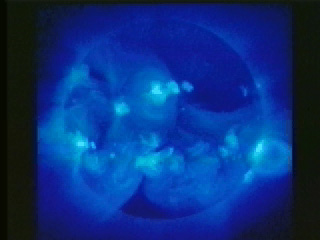
Most of us think of the Sun as a quiet ball of steadily burning gas that provides the light and heat necessary for life to exist on Earth. As it turns out, our Sun is anything but quiet. Unpredictable explosions on the surface release tons of material that races out into the solar system causing communication satellites to malfunction, power grids on Earth's surface to overload, and the eerie northern and southern lights to glow at high latitudes. Inside the Sun, nuclear fusion operating at 15 million degrees combines hydrogen atoms into larger helium atoms in a process that releases energy that keeps the Sun from collapsing under its own weight.
As it turns out, many of the stars in the night sky are very similar to our Sun. If astronomers can understand the physical mechanisms that cause our Sun to act as it does, then those same principles should apply to the many distant Suns we see in the heavens. Understanding the physical processes that govern our Sun will help us better understand the distant stars twinkling in the night sky.
Alternative presentation (using IFRAME for video, use Preview command to view):

Most of us think of the Sun as a quiet ball of steadily burning gas that provides the light and heat necessary for life to exist on Earth. As it turns out, our Sun is anything but quiet. Unpredictable explosions on the surface release tons of material that races out into the solar system causing communication satellites to malfunction, power grids on Earth's surface to overload, and the eerie northern and southern lights to glow at high latitudes. Inside the Sun, nuclear fusion operating at 15 million degrees combines hydrogen atoms into larger helium atoms in a process that releases energy that keeps the Sun from collapsing under its own weight.
As it turns out, many of the stars in the night sky are very similar to our Sun. If astronomers can understand the physical mechanisms that cause our Sun to act as it does, then those same principles should apply to the many distant Suns we see in the heavens. Understanding the physical processes that govern our Sun will help us better understand the distant stars twinkling in the night sky.
1.2 Our Star, the Sun: Observation
Observation: Our Star, The Sun
Determining the Lifetime of a Solar Granule

Question
Your task is to determine the approximate lifetime of a solar granule on the visible surface of the Sun. Select an area then slowly and rhythmically repeat, "start, stop, start, stop" until you can consistently predict the appearance and disappearance of the cells, called granules. While keeping your rhythm, move to a different area of the video and continue monitoring the appearance and disappearance of granules. When you are confident you have the timing right, move your eyes (or use a partner) to the clock and determine the length of time between the appearance and disappearance of the granules and record your answer in the space below.
1.3 Tutorials
THIS WOULD BE A GOOD SPOT FOR SOME INTRO CONTENT FOR THE TUTORIALS SECTION. - STG
1.3.1 Tutorials: Solar Interior
THIS SECTION SHOULDN'T APPEAR, FOR HIERARCHICAL PURPOSES ONLY. - STG
1.3.2 Our Star, the Sun: Solar Interior
Solar Interior Tutorial: 01
Considering the Sun's Interior

Question
The image at right shows the Sun's photosphere as seen from Earth's surface. The photosphere is the dense layer of the Sun below which we cannot see. In the space below, describe what you think the interior of the Sun is like using complete sentences. Be as specific as possible about your reasoning of what might be happening to the Sun's luminosity, mass, temperature, and density at the center, near the edge, and half-way in between.
1.3.3 Our Star, the Sun: Solar Interior
Solar Interior Tutorial: 02
A Journey Into the Sun
Although we cannot directly see beneath the photosphere (more info), we can use the laws of physics to infer what must be going on there. In particular, astronomers create computer models that describe how luminosity, mass, temperature and density must be changing with increasing distance from the center. The table below shows that the Sun's luminosity is completely generated within one-quarter of the radius and that most of the Sun's mass is concentrated inside one-half of the Sun's radius. The temperature inside the Sun is highest in the center at nearly 16 million degrees and the temperature decreases with distance from the center. Not surprisingly, the Sun's density is greatest at the center, 14 times denser than lead, and the Sun's density decreases as you move out toward the photosphere.
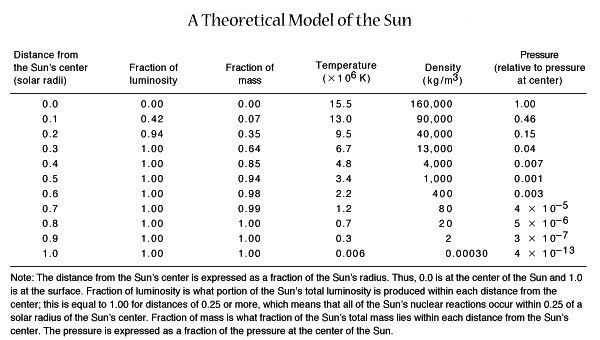
1.3.4 Our Star, the Sun: Solar Interior
Solar Interior Tutorial: 03
Self Test: A Theoretical Model of the Sun

Click here (http://bcs.whfreeman.com/aol/content/cat_030/ch18/m18t001p03ST.html) to view the exercise in an external window.
1.3.5 Our Star, the Sun: Solar Interior
Solar Interior Tutorial: 04
The Sun's Center
Why might the Sun shine?
- Initial High Temperature: If the Sun was formed very hot, maybe it is just slowly cooling down and releasing energy.
- Gravitational Contraction: If the Sun has immense gravity, maybe it is compressing and heating its interior gases.
- Fuel Burning: If the Sun shines, maybe it is burning coal or some other familiar energy source deep inside.
- Thermonuclear Fusion: If the center is hot enough and dense enough, maybe hydrogen atoms are combining to make helium and releasing energy according to E=mc2.
Over history, scientists have fiercely debated what causes the Sun and the stars to shine. The box at right lists several mechanisms proposed over the years. As it turns out, only the process of thermonuclear fusion can provide enough energy over the long term to account for the intense brightness of the Sun. According to Einstein's mass-to-energy conversion equation, E=mc2, the Sun must be converting 600 billion kilograms of hydrogen into helium every second. Given that the Sun's mass is 333,000 times more than Earth, there is enough hydrogen inside the Sun to keep this process going at its current rate for a total of about 10 billion years. So far, the Sun has only used about one-half of its easily available hydrogen supply.
If the Sun's center is the location of highest temperature and highest density, it might not surprise you that the center is where the Sun's thermonuclear fusion power source is located. At temperatures in excess of 10 million degrees, as in the center of the Sun where the temperature is nearly 16 million degrees, hydrogen atoms combine to make helium atoms in a thermonuclear reaction called the proton-proton chain.
As shown in the figure below, three principal steps define this process. First, two hydrogen atoms combine to create a deuterium isotope, a neutrino, and a positron. A deuterium isotope is simply a hydrogen atom with an extra neutron in its nucleus, a neutrino is a nearly massless particle that escapes the Sun quickly, and a positron is a subatomic particle that quickly annihilates by colliding with a nearby electron, releasing a gamma ray. In the second step, the deuterium isotope combines with another hydrogen atom that creates a helium-3 isotope and another gamma ray. The helium-3 isotope has one neutron less than the more familiar helium-4 atom that has two neutrons. Finally, two helium-3 isotopes combine to make a stable helium-4 atom and release two hydrogen atoms in the process that can be used again and again. This process accounts for the vast majority of the Sun's energy output.

1.3.6 Our Star, the Sun: Solar Interior
Solar Interior Tutorial: 05
Energy Transport Inside the Sun
Once energy leaves the Sun's core, it takes a very long time for the energy, in the form of gamma rays released in the proton-proton chain, to make its way 696,000 km out to the photosphere. As gamma-ray photons are released, they do not travel very far before colliding with a nearby ion. When they bounce off that ion, they may or may not move in a direction pointing outward before they collide with yet another ion. The result is that it can take nearly a million years for photons to make their way out of the Sun.
Because the density is highest in the inner half of the Sun, collisions among ions and photons increase the temperature. This energy escapes the core through the process of radiative transfer by transferring energy to the more distant and cooler regions. At larger distances from the core, the Sun's density is considerably less, and a different energy transfer process takes place. Hotter regions expand and then float towards the photosphere because they are less dense. The overlying cooler regions then sink towards the center, and the process repeats itself. This churning motion where hot material moves upward and cooler material sinks is called convection. The result is that there are three distinct regions to the Sun's interior: the core where thermonuclear fusion is taking place, the radiative zone where energy is transferred via radiative transfer, and the outer convective envelope where material is actually moving up and down in circular cells.

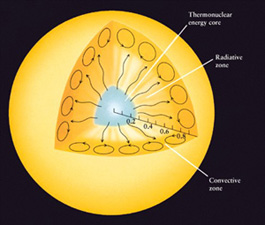
1.3.7 Our Star, the Sun: Solar Interior
Solar Interior Tutorial: 06
Self Test: The Sun's Internal Structure

Click here (http://bcs.whfreeman.com/aol/content/cat_030/ch18/m18t001p06ST.html) to view the exercise in an external window.
1.3.8 Our Star, the Sun: Solar Interior
Solar Interior Tutorial: 07
Helioseismology
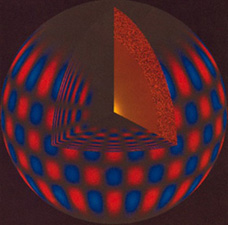

In much the same way that geologists on Earth can infer the hidden structure of Earth's interior by looking carefully at how seismic waves from earthquakes move through the Earth, astronomers can determine the Sun's interior structure by monitoring how waves pass through the Sun.
Helioseismology allows astronomers to probe the solar interior using the Sun's own vibrations
Listen to the Sun (linked to: http://soi.stanford.edu/results/thr_modes_1_0_1_2_30s.au)
Seismic waves move throughout the solar interior causing the surface to move up and down by about 10 meters every 5 minutes. These waves bounce back and forth through the solar interior. Careful analysis has shown that the Sun rotates differently on the inside than it does on the outside. The outer 20 percent of the Sun seems to have a variable rotation rate. Material at the poles spins around the Sun in about 35 days whereas material at the equator moves around the Sun in about 25 days. Inside, the Sun seems to be moving like a rigid sphere in 27 days. Helioseismologists have also been able to determine the exact depth of the convection zone overlying the radiative zone using this technique.
1.3.9 Our Star, the Sun: Solar Interior
Solar Interior Tutorial: 08
The Solar Neutrino Problem
Searching for Neutrinos beyond the Textbooks
an essay by John N. Bahcall

In attempting to understand the Sun, physicists, chemists, and astronomers have been confronted with a mystery—the case of the missing neutrinos. In the early 1960s, Ray Davis and I proposed to test the theory of how the Sun shines. Ray, a chemist at Brookhaven National Laboratory, had developed a neutrino detector that uses a cleaning fluid containing chlorine. Using standard theories of physics and astronomy, I calculated the rate at which neutrinos are produced in the Sun. I could then predict the rate at which neutrinos should be captured in the largest detector Ray could build. If my calculations matched experiment, they would confirm that the Sun shines by nuclear fusion in its interior.
The actual experiment used 100,000 gallons of perchloroethylene, about enough to fill an Olympic swimming pool. Ray and his collaborators put their detector in a deep gold mine, to shield it from other particles that hit the surface of the Earth. To everyone’s surprise, Ray’s chlorine detector captured many fewer neutrinos than I had predicted. The results were challenged and checked repeatedly over the following three decades, but always with the same result: many neutrinos appear to be missing! The case of the missing neutrinos has grown stronger with time. Three other experiments, each with a different type of detector, searched for neutrinos from the Sun. They all found fewer than I predicted.
What could be wrong? Where have the neutrinos gone? There are three possibilities. Either the experiments are wrong, the standard model of how the Sun (and other stars) shine is wrong, or something happens to the neutrinos after they are produced. New experiments are now under way in Japan, in Italy, and in Canada to test these hypotheses.
1.3.10 Our Star, the Sun: Solar Interior
Solar Interior Tutorial: 09
The Solar Neutrino Problem
Searching for Neutrinos beyond the Textbooks (continued)
Most people working in the field think that the last of the three explanations is most likely to be correct: Only physics beyond the standard textbooks can describe what has happened to solar neutrinos. Somehow, most physicists think, neutrinos created in the solar interior change into neutrinos that are more difficult to detect as they pass out of the Sun and travel to the Earth. They change their personalities, so to speak! If this is correct, it would be the first experimental demonstration of a process beyond the standard model of particle physics.
So far, evidence for the new physics is only circumstantial. We know only that the results differ markedly from predictions based on our understanding now of how the Sun shines. Future experiments designed to search for a "smoking gun"—unequivocal evidence of processes not in the physics textbooks—will use the fact that neutrinos come in different types. Most easily detected are the so-called electron-type neutrinos; more difficult to detect are muon-type and tau-type neutrinos.
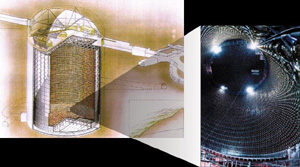
Suppose some of these neutrinos from the Sun convert into neutrinos that are easier to detect as they pass through the Earth at night on their way to the detector. The change would make the Sun appear brighter (in terms of neutrinos) at night than in the day . If that were seen, it would provide a dramatic demonstration that unconventional physics is occurring.
If such a smoking gun is found, it could offer a clue to new laws of particle physics. Recent experiments in Japan using neutrinos produced in the Earth’s atmosphere by energetic particles from outside our solar system (cosmic rays) have already shown that neutrinos have a tiny mass, which allows them to convert from one type to another. Observations of solar neutrinos may lead us to further revise the laws which govern the smallest scales of matter.
1.3.11 Our Star, the Sun: Solar Interior
Solar Interior Tutorial: 10
The Solar Neutrino Problem
Searching for Neutrinos beyond the Textbooks (continued)
I do not know the correct explanation for the missing neutrinos. However, the particle-physics (split-personality) explanation has a mathematical beauty and simplicity that are very attractive. If the deity has not chosen this solution to the mystery, then he or she has missed an excellent opportunity to enrich the laws of the universe.
However, the real message of the experiments on solar neutrinos is even more remarkable. It is that working on the frontier of science, you may stumble across something that is beautiful and unexpected. We do not yet know precisely what we have discovered with solar neutrinos, but we do know that future experiments will solve the mystery for us. Their outcome might point the way to a better understanding of fundamental physics and of the stars.
John N. Bahcall
Neutrinos from the Sun have been detected, but in smaller numbers than expected.
1.3.12 Our Star, the Sun: Solar Interior
Solar Interior Tutorial: 11
Reconsidering the Sun's Interior
Earlier in this tutorial, you described your concept of the Sun's interior as the following:
(ANSWER FROM FIRST SLIDE/QUESTION WOULD BE SHOWN HERE)
Again, describe the interior of the Sun and be sure to use and explain terms including:
- luminosity
- percent mass
- temperature
- density
- thermonuclear fusion
- proton-proton chain
- core
- radiative zone
- convection zone
- helioseismology
- the neutrino problem
Question
You also should make specific references to how this answer is different from your earlier answer.
1.3.13 Tutorials: The Solar Atmosphere
THIS SECTION SHOULDN'T APPEAR, HERE FOR HIERARCHICAL PURPOSES ONLY. - STG
1.3.14 Our Star, the Sun: The Solar Atmosphere
The Solar Atmosphere Tutorial: 01
Considering the Sun in a Different Light

Question 1.1
The video at right shows the sunspots on the photosphere as seen from Earth's surface shown over a two-week period. In the space below, describe your reasons for whether or not the Sun rotates using complete sentences. If you think it does rotate, indicate how long it takes to spin. If you think it does not, describe why you think it does not. Be as specific as possible about your reasoning.
1.3.15 Our Star, the Sun: The Solar Atmosphere
The Solar Atmosphere Tutorial: 02
Observing the Sun from Earth's Surface

Looking up at the Sun from Earth's surface, you might wonder if there is anything remotely interesting about a seemingly quiet ball of glowing gas. The "surface" of the Sun that we see from Earth is called the photosphere (more info). The word photosphere quite literally means "the sphere of light." The photosphere has a steady temperature of 5800K.
The photosphere is the lowest of three main layers in the Sun's atmosphere.
1.3.16 Our Star, the Sun: The Solar Atmosphere
The Solar Atmosphere Tutorial: 03
Granulation on the Photosphere
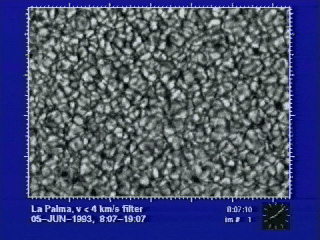
Close inspection with specially designed telescopes shows that the surface of the photosphere is bubbling in a pattern called granulation (more info). Each of the individual granules is about 1000 km across - the size of a large state in the United States. Granulation is caused by convection (more info) in the photosphere. Gas from lower levels of the photosphere is heated by the material underneath causing it to rise to the surface of the photosphere. At the surface, the gas cools and contracts then descends back into the deep photosphere in much the same process that water violently boils in a pot on the stove.
To "hear" sounds that the boiling photosphere makes, click here to access the Solar Sounds Web page.
1.3.17 Our Star, the Sun: The Solar Atmosphere
The Solar Atmosphere Tutorial: 04
Sunspots

Probably the most obvious features of the Sun's photosphere are dark blotches known as sunspots (more info). These irregularly shaped regions appear darker than the surrounding photosphere because they are at a lower temperature and do not shine as brightly. The dark center of each sunspot is called the umbra while the lighter area around the edge is called the penumbra. Sunspot lifetimes range anywhere from a few hours to several months. Sunspot sizes vary enormously as well, ranging in size from a few kilometers across to nearly the size of Jupiter.
Sunspots are low-temperature regions in the photosphere.
1.3.18 Our Star, the Sun: The Solar Atmosphere
The Solar Atmosphere Tutorial: 05
Eleven-Year Sunspot Cycles
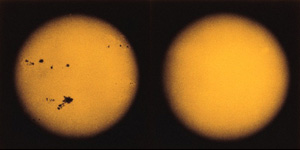
Observing sunspots with specially designed telescopes is largely a matter of chance. On any given day, there could be many or no sunspots visible. However, there are times when sunspots are more common than other times. The average number of sunspots varies with a period of about 11 years (more info). The exact cause of the 11-year cycle still eludes astronomers but is likely related to both the magnetic field of the Sun and its variable rotation rate (more info).
A current image of the Sun is available from the Big Bear Solar Observatory.
1.3.19 Our Star, the Sun: The Solar Atmosphere
The Solar Atmosphere Tutorial: 06
Estimating the Rotation Rate of the Sun with Sunspots

Question 1.2
The image at right, Tracking the Sun's Rotation with Sunspots, shows the Sun every day for about 6 weeks. Determine the length of time it takes the Sun to rotate once and fully explain your reasoning.
1.3.20 Our Star, the Sun: The Solar Atmosphere
The Solar Atmosphere Tutorial: 07
Observing Solar Rotation

Galileo discovered that he could determine that the Sun rotates about once each month by tracking sunspots as they move from one side of the Sun to the other. Over the years, careful observation revealed that different latitudes of the Sun rotate at different rates. Specifically, the equatorial regions rotate much faster than the polar regions. A sunspot near the equator can go around the Sun in about 25 days whereas material at the poles can take as much as 35 days to orbit the Sun's axis once.
Today, spacecraft such as the Yohkoh SXT Solar Observatory and the SOHO Satellite closely monitor the Sun's atmosphere and rotation.
1.3.21 Our Star, the Sun: The Solar Atmosphere
The Solar Atmosphere Tutorial: 08
Seeing the Sun in a Different Light
The chromosphere is located between the photosphere and the Sun's outermost atmosphere. The corona is the outermost layer of the Sun's atmosphere.
When viewed from outside Earth's protective atmosphere, we observe an entirely different Sun than the quiet Sun seen from Earth's surface. Just above the photosphere is a region called the chromosphere(more info), the sphere of color. A mysterious phenomenon occurs in the corona. For some reason, still unknown, the temperature increases dramatically in the corona from thousands of degrees to millions of degrees (more info). This is odd because one would expect that the farther you get from the hot surface of the Sun, the cooler it should become. In the chromosphere, it is exactly the opposite.
Above the chromosphere is the top layer of the solar atmosphere, the corona(more info). The corona extends from the top of the chromosphere out to a distance of several million kilometers. The corona is almost empty space, having a density of only about 1011 atoms per cubic meter of gas compared to about 1023 atoms per cubic meter of air that we breathe. Yet the atoms there are moving at tremendous velocities, and when they collide, they release high-energy X-ray photons. These X-ray photons are only visible from satellites above Earth's protective atmosphere.
1.3.22 Our Star, the Sun: The Solar Atmosphere
The Solar Atmosphere Tutorial: 09
Self Test: The Solar Atmosphere

Click here (http://bcs.whfreeman.com/aol/content/cat_030/ch18/m18t002p09ST.html) to view the exercise in an external window.
1.3.23 Our Star, the Sun: The Solar Atmosphere
The Solar Atmosphere Tutorial: 10
Explosions on the Sun
Probably the most violent event occurring in our solar system are explosions on the Sun known as a coronal mass ejection or CME. During a CME, more than 1012 kilograms of high-temperature coronal gas are suddenly ejected into outer space at speeds reaching 400 kilometers per second. The ejected material can reach Earth in about 3 days and causes disturbances in Earth's magnetosphere. These disturbances can cause satellite electronics to fail, communication systems to be interrupted, health hazards for astronauts, and displays of auroras.
1.3.24 Our Star, the Sun: The Solar Atmosphere
The Solar Atmosphere Tutorial: 11
Self Test: Faces of the Sun

Click here (http://bcs.whfreeman.com/aol/content/cat_030/ch18/m18t002p11ST.html) to view the exercise in an external window.
1.3.25 Our Star, the Sun: The Solar Atmosphere
The Solar Atmosphere Tutorial: 12
Reconsidering the Sun in a Different Light
Earlier in this tutorial, you described the rotation rate of the Sun as the following:
(ANSWER FROM FIRST SLIDE/QUESTION WOULD BE SHOWN HERE)
Question
Again, describe the rotation rate of the Sun and be sure to use and explain your reasoning.
1.4 Activities
INTRO TEXT?
1.4.1 How Big Are Sunspots?
How Big Are Sunspots?

Question 1.3
Consider the photograph of the Sun's photosphere above and determine the measured horizontal diameter of the Sun in mm using a ruler.*??
Determine the "scale" of the image by dividing the actual diameter (1.4 x 106 km) by the measurement of the horizontal diameter of the Sun in mm. This is the "scale factor" in units of "actual_km / measured_mm"*??
On the image, find the two small sunspots at the middle left and the two larger sunspots in the upper center. Measure the maximum diameters of all four. *??
Convert the measured diameters of the smallest and the largest sunspots to actual kilometers by multiplying by the "scale factor" determined above. *??
How do these sunspots compare to the distance between New York and Los Angeles? The distance between New York and Los Angeles is 3944 km. *??
How do these sunspots compare to the diameter of the Earth? The diameter of Earth is 12756 km. *??
1.4.2 Determining the Rotation Rate of the Sun Using X-Ray Movies?
Determining the Rotation Rate of the Sun Using X-Ray Movies?
View the video, An X-Ray Look at the Sun several times before completing the following questions.
Question 1.4
In the movie, the left-hand side of the Sun is moving towards you and the right-hand side is moving away from you. If you were above the rotating Sun looking down, would it be moving in a clockwise sense or a counter-clockwise sense? *??
Using a stopwatch or a wristwatch that indicates seconds, determine the length of time the entire movie takes and record the number of seconds. This is equivalent to 22 days in real-time. *??
At the beginning of the movie, there is a large active region at the center of the left-hand edge. Using a stopwatch or a wristwatch that indicates seconds, determine how long it takes for this particular active region to move from one-side of the Sun to the other side. How many seconds did this take? *??
Determine the actual rotation period of the Sun. (Hint: Divide 22 days by the time it takes for the entire movie, and then multiply that result by the time it takes for the active region to move across the Sun—this is one-half the rotation period of the Sun. *??
In several sentences, write a description of what happens to the target active region over the course of this time-lapse video. *??
1.5 Examination
Our Star, the Sun: Self Test
THIS GOES INTO THE QUESTION TITLE: Astronomy Online Chapter 18
(20 multiple choice questions follow)